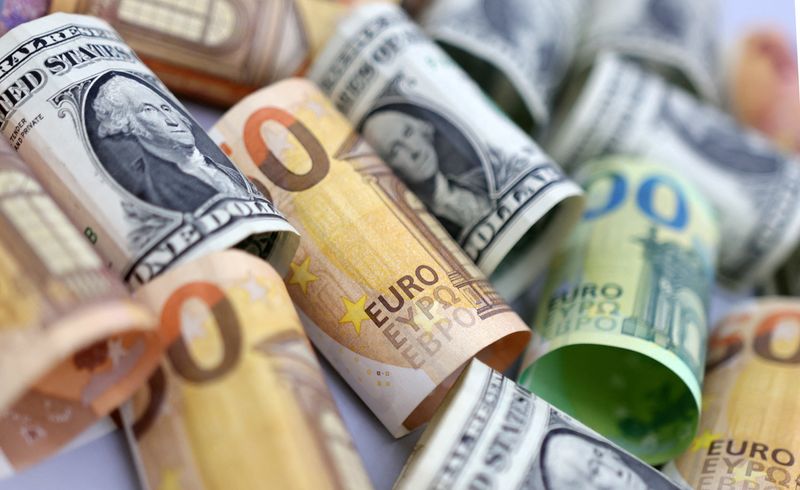Forex
Dollar steadies near 11-week high, Fed policy path in focus


© Reuters. FILE PHOTO: U.S. Dollar and Euro banknotes are seen in this illustration taken July 17, 2022. REUTERS/Dado Ruvic/Illustration/File Photo
By Stefano Rebaudo and Ankur Banerjee
(Reuters) -The U.S. dollar was up slightly on Tuesday, close to its highest level in almost three months, while the Australian dollar ran out of steam after rising earlier in the session.
A string of robust U.S. economic data and remarks from Federal Reserve Chair Jerome Powell have quashed speculation of early and steep interest rate cuts and supported the greenback.
Traders are currently pricing in only a 16% chance of a cut in March, the CME FedWatch tool showed, compared with a 69% chance at the start of the year.
They are also now pricing in around 115 basis points (bps) of cuts this year, compared with around 150 bps anticipated in early January.
The , which measures the U.S. currency against six others, rose 0.1% to 104.58, having touched 104.60 on Monday, its highest since Nov. 14.
“There seems little incentive for investors and corporates to offload any of their dollar holdings,” said Chris Turner global head of markets at ING.
“There is also the looming China Lunar New Year holiday next week, which may make the market reluctant to carry short dollar positions in an uncertain geopolitical environment,” he added.
Some analysts still see a positive outlook for the greenback.
“The real debate is not if the Fed cuts a few weeks sooner or later, but if it cuts by less or more than the rest of the world over the next two years,” said George Saravelos, global head of forex research at Deutsche Bank.
“We continue to see the risks skewed towards less Fed easing and therefore in favour of the U.S. dollar,” he added.
The euro was down 0.1% at $1.0732%.
German industrial orders unexpectedly jumped in December, while euro zone consumers have trimmed their expectations for inflation over the next 12 months.
“German data are supporting the single currency,” said Roberto Mialich, forex strategist at UniCredit.
“A potential repricing of the ECB (European Central Bank) policy path towards a first rate cut in June instead of April, which we regard as likely, would prop up the euro in the medium term,” he added.
The Reserve Bank of Australia (RBA) on Tuesday left rates unchanged, but cautioned about a possible further monetary tightening.
The rose 0.05% to $0.6492, inching away from the 2-1/2 month low of $0.6469 it touched on Monday. The New Zealand dollar was 0.13% higher at $0.6063.
The repricing of the RBA monetary path “helps to provide modest support for the Australian dollar in the near-term,” said Lee Hardman, senior currency analyst, at MUFG.
“Sentiment towards the Aussie has also been boosted indirectly overnight by the rebound in the Chinese equity market where speculation is building over further state policy action to provide stability,” he added.
The Aussie dollar is usually strongly correlated to Chinese stocks, as China is Australia’s largest trading partner.
Chinese stocks recorded their biggest one-day gain since 2022 and the yuan rose on a slew of signals that authorities are strengthening their resolve to support slumping markets.
Sterling last fetched $1.2565, up around 0.15% on the day, but remained close to Monday’s seven-week low.
The pound’s fall on Monday came despite some upbeat economic data. Figures showed that UK unemployment was likely much lower late last year than previously thought, which could push out British rate cuts too.
The Japanese yen was stronger on the day at 148.71 per dollar, but not far off a two-month low of 148.90.
Japan’s real wages fell for a 21st straight month, though at a slower pace, while household spending dropped for a 10th consecutive month, showing inflation outpaced wage recovery and continued to weigh on consumer spending.

 Forex3 years ago
Forex3 years agoForex Today: the dollar is gaining strength amid gloomy sentiment at the start of the Fed’s week

 Forex3 years ago
Forex3 years agoUnbiased review of Pocket Option broker

 Forex3 years ago
Forex3 years agoDollar to pound sterling exchange rate today: Pound plummeted to its lowest since 1985

 Forex3 years ago
Forex3 years agoHow is the Australian dollar doing today?

 Cryptocurrency3 years ago
Cryptocurrency3 years agoWhat happened in the crypto market – current events today

 World3 years ago
World3 years agoWhy are modern video games an art form?

 Commodities3 years ago
Commodities3 years agoCopper continues to fall in price on expectations of lower demand in China

 Economy3 years ago
Economy3 years agoCrude oil tankers double in price due to EU anti-Russian sanctions





















